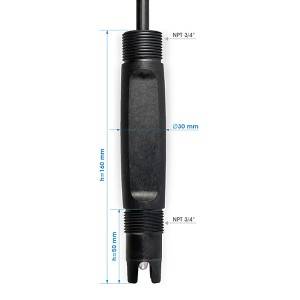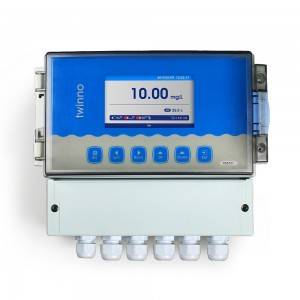Products
-

Online Conductivity / Resistivity / TDS / Salinity Meter T6530
Industrial online conductivity meter is a microprocessor-based water quality online monitoring control instrument, the salinometer measures and supervises the salinity (salt content) by conductivity measurement in fresh water. The measured value is displayed as ppm and by comparing the measured value to a user defined alarm set point value, relay outputs are available to indicate if salinity is above or below the alarm set point value. -

T6530 Online Conductivity / Resistivity / TDS / Salinity Meter
Industrial online conductivity meter is a microprocessor-based water quality online monitoring control instrument, the salinometer measures and supervises the salinity (salt content) by conductivity measurement in fresh water. The measured value is displayed as ppm and by comparing the measured value to a user defined alarm set point value, relay outputs are available to indicate if salinity is above or below the alarm set point value. -

Optical Dissolved Oxygen Analyzer DO Meter T6546 Apure digital aquaculture
Industrial online dissolved oxygen meter is an online water quality monitor and control instrument with microprocessor. The instrument is equipped with fluorescent dissolved oxygen sensors. The online dissolved oxygen meter is a highly intelligent online continuous monitor. It can be equipped with fluorescent electrodes to automatically achieve a wide range of ppm measurement. It is a special instrument for detecting oxygen content in liquids in environmental protection sewage related industries. -

Online Optical Dissolved Oxygen Analyzer DO Meter T6546
Industrial online dissolved oxygen meter is an online water quality monitor and control instrument with microprocessor. The instrument is equipped with fluorescent dissolved oxygen sensors. The online dissolved oxygen meter is a highly intelligent online continuous monitor. It can be equipped with fluorescent electrodes to automatically achieve a wide range of ppm measurement. It is a special instrument for detecting oxygen content in liquids in environmental protection sewage related industries. -

Online Chlorine Dioxide Meter T4053
Online chlorine dioxide meter is a microprocessor-based water quality online monitoring control instrument. -

Online Ultrasonic Sludge Interface Meter T6580
The Ultrasound Sludge Interface sensor can be used to continuously and accurately determine the Liquid Level. Stable data, reliable performance; built-in self-diagnosis function to ensure accurate data; simple installation and calibration. -

Online Residual Chlorine Meter T4050
Online residual chlorine meter is a microprocessor-based water quality online monitoring control instrument. -

CS1768 pH Electrode
Designed for viscous fluids, protein environment, silicate, chromate, cyanide, NaOH, seawater, brine, petrochemical, natural gas liquids, high-pressure environment. -

CS1768 Plastic Housing Industrial Online pH Sensor for Wastewate
Designed for viscous fluids, protein environment, silicate, chromate, cyanide, NaOH, seawater, brine, petrochemical, natural gas liquids, high-pressure environment.The electrode material PP has high impact resistance, mechanical strength and toughness, resistance to a variety of organic solvents and acid and alkali corrosion.Digital sensor with strong anti-interference ability, high stability and long transmission distance. -

CS3752GC EC Conductivity TDS Resistivity Electrode Probe Sensor
Conductivity digital sensor is a new generation of intelligent water quality detection digital sensor independently developed by our company. High performance CPU chip is used to measure conductivity and temperature. The data can be viewed, debugged and maintained through mobile app or computer. It has the characteristics of simple maintenance, high stability, excellent repeatability and multifunction, and can accurately measure the conductivity value in solution. Environmental water discharge monitoring, Point source solution monitoring, Wastewater treatment works, Diffuse pollution monitoring, IoT Farm, IoT Agriculture Hydroponics sensor, Upstream Petrochemicals, Petroleum Processing, Paper Textiles waste water, Coal, Gold and Copper Mine, Oil and Gas Production and Exploration, River water quality monitoring, Groundwater water quality monitoring, etc -

CS3752C EC Conductivity TDS Resistivity Electrode Probe Sensor
Conductivity digital sensor is a new generation of intelligent water quality detection digital sensor independently developed by our company. High performance CPU chip is used to measure conductivity and temperature. The data can be viewed, debugged and maintained through mobile app or computer. It has the characteristics of simple maintenance, high stability, excellent repeatability and multifunction, and can accurately measure the conductivity value in solution. Environmental water discharge monitoring, Point source solution monitoring, Wastewater treatment works, Diffuse pollution monitoring, IoT Farm, IoT Agriculture Hydroponics sensor, Upstream Petrochemicals, Petroleum Processing, Paper Textiles waste water, Coal, Gold and Copper Mine, Oil and Gas Production and Exploration, River water quality monitoring, Groundwater water quality monitoring, etc -

CS3742G EC Conductivity TDS Resistivity Electrode Probe Sensor
Conductivity digital sensor is a new generation of intelligent water quality detection digital sensor independently developed by our company. High performance CPU chip is used to measure conductivity and temperature. The data can be viewed, debugged and maintained through mobile app or computer. It has the characteristics of simple maintenance, high stability, excellent repeatability and multifunction, and can accurately measure the conductivity value in solution. Environmental water discharge monitoring, Point source solution monitoring, Wastewater treatment works, Diffuse pollution monitoring, IoT Farm, IoT Agriculture Hydroponics sensor, Upstream Petrochemicals, Petroleum Processing, Paper Textiles waste water, Coal, Gold and Copper Mine, Oil and Gas Production and Exploration, River water quality monitoring, Groundwater water quality monitoring, etc -

CS3742 Conductivity Electrode
Conductivity digital sensor is a new generation of intelligent water quality detection digital sensor independently developed by our company. High performance CPU chip is used to measure conductivity and temperature. The data can be viewed, debugged and maintained through mobile app or computer. It has the characteristics of simple maintenance, high stability, excellent repeatability and multifunction, and can accurately measure the conductivity value in solution. Environmental water discharge monitoring, Point source solution monitoring, Wastewater treatment works, Diffuse pollution monitoring, IoT Farm, IoT Agriculture Hydroponics sensor, Upstream Petrochemicals, Petroleum Processing, Paper Textiles waste water, Coal, Gold and Copper Mine, Oil and Gas Production and Exploration, River water quality monitoring, Groundwater water quality monitoring, etc -

Industrial Online Fluoride Ion Concentration Transmitter T6510
Industrial online Ion meter is an online water quality monitoring and control instrument with microprocessor. It can be equipped with Ion
selective sensor of Fluoride, Chloride, Ca2+, K+, NO3-, NO2-, NH4+, etc.The instrument is widely used in industrial waste water, surface water, drinking water, sea water, and industrial process control ions on-line automatic testing and analysis, etc. Continuously monitor and control Ion concentration and temperature of aqueous solution. -

Oxygen Demand COD Sensor Sewage Water Treatment Quality Monitoring RS485 CS6602D
Introduction:
COD sensor is a UV absorption COD sensor, combined with a lot of application experience, based on the original basis of a number of upgrades, not only the size is smaller, but also the original separate cleaning brush to do one, so that the installation is more convenient, with higher reliability.It does not need reagent, no pollution, more economic and environmental protection.On-line uninterrupted water quality monitoring.Automatic compensation for turbidity interference, with automatic cleaning device, even if long-term monitoring still has excellent stability.



